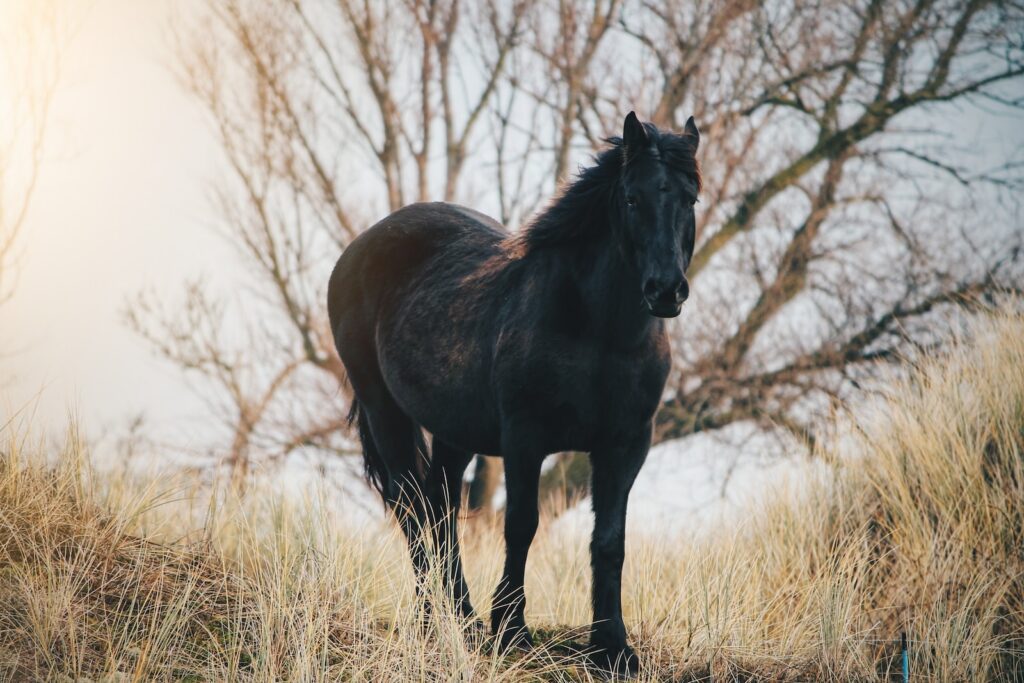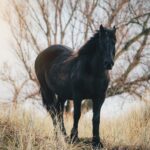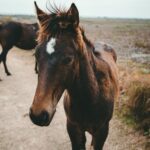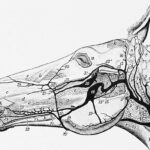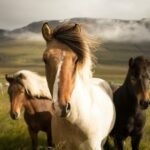There’s something undeniably striking about a glossy black horse. While not the most common equine color, black coats can be found across numerous horse breeds, from nimble Arabians to powerful draft horses. When a black horse is well-groomed, their sleek coat seems to absorb the light, creating a dazzling effect. Beyond aesthetics, many black horse breeds also have long histories, unique talents, and gentle dispositions that make them excellent choices as riding and working horses. This article will journey through some of the world’s most beautiful black horse breeds, exploring their origins, characteristics, and uses. Discover what makes these dark beauties so captivating and beloved.
Friesian
Perhaps one of the most iconic black horse breeds is the Friesian, hailing from Friesland in the Netherlands. Entirely black in color, the Friesian strikes a stunning figure with its muscular build, flowing mane and tail, and distinctive feathers on the lower legs. In fact, any white markings are discouraged by the breed registry. The Friesian’s luxurious black coat is the result of selective breeding dating back to the Middle Ages. Originally used as war horses and later as carriage horses, the breed’s stylish aesthetics and movement lent themselves well to these tasks.
Standing on average 15 to 17 hands high and weighing 1,200 to 1,500 pounds, the Friesian is a substantial horse. However, its strong limbs and short back give it agility and grace belying its size. The breed performed well as harness racers in the late 1800s. Though their numbers dwindled in the 20th century with mechanization, the dramatic and personable Friesian has regained popularity as a riding and show horse. The breed excels at dressage with their high-stepping gaits, and their majestic appearance makes them naturals in exhibitions and parades. Beyond the show ring, the Friesian’s steady temperament and trainability make them excellent all-around riding horses. Their flowing black coat ensures they attract attention wherever they go.
Andalusian
With its origins on the Iberian peninsula, the Andalusian horse conjures images of high rearing war horses from medieval tales. Though most Andalusians sport gray coats, a jet black Andalusian is exceptionally striking with its robust musculature and flowing mane and tail. Selective breeding among Spanish livestock has produced this distinct breed for several centuries. The Carthusian monks are credited with maintaining the breed’s classic characteristics during the 13th to 15th centuries. Primarily used as war horses through the 17th century, Spanish horses also spread widely through Europe. Exports to other nations were later restricted to maintain desired traits.
Andalusians typically stand around 15.2 hands high and weigh 900 to 1,100 pounds. Their strong, short backs allow collection and agile movements. Known for their intelligence and sensitivity, they are quick to learn. This athleticism and trainability make Andalusians highly successful dressage and show jumping mounts. Additionally, their striking appearance has led to frequent film appearances. Whether prancing through a dressage test or displaying battle prowess, the sleek black Andalusian always makes a statement. Their presence and talents have garnered enthusiasts around the globe.
Morgan Horse
With its foundation tracing to one stallion in 18th century Vermont, the Morgan horse is treasured as an early American breed. All Morgans descend from the horse known as Figure, who sired a line of horses with its speed, strength, and temperament. Black is a common Morgan color, along with chestnut and bay. Their stocky yet refined build shows muscle tone and an arched neck, typically standing between 14.2 and 15.2 hands high. The breed takes its name from Figure’s owner Justin Morgan.
Morgans first gained renown as racehorses in New England, showing grit and fierce competitive spirit. Their abilities soon found demand on farms and among settlers heading west. The breed’s intelligence and calm nature made Morgans excellent cavalry horses during the Civil War. Their versatility allowed them to transition easily to field and harness work. Today Morgans excel in many disciplines including jumping, combined driving, dressage, reining, and endurance. Amateur horsemanship programs have long relied on the level-headed Morgan as the ideal all-around mount. Their steady temperament and strong work ethic continue to win devotees across the nation.
Fell Pony
In the rocky fells of northern England, a hardy black pony breed developed to traverse the challenging terrain. The Fell pony takes its name from its mountainous homeland, where it has served as a reliable utility animal and family horse for centuries. Most Fells sport black coats, though bay, brown, and gray variations occur in the breed. They typically stand between 13.2 and 14 hands high. Selective breeding likely crossed native ponies with Iberian and Arabian blood. Their strength and agility proved invaluable working the remote farms dotting the fells.
Fells frequently transported livestock and goods between the villages and mountain pastures. Traditional pack pony races still test the breed’s speed and stamina. Though mechanization and roads reduced their traditional jobs, devotion to the breed allowed their numbers to recover. The Fell Pony Society, formed in 1922, maintains pedigree records. The breed’s steady temperament and athleticism enabled its transition to a popular riding pony. Surefooted and adaptable, Fells now shine in dressage, jumping, driving, and trail riding. And their shaggy winter coat continues to provide warmth in the wet, cold climates. The enduring Fell Pony is a testament to the value of Britain’s native pony breeds.
American Mustang
No animal encapsulates the spirit of the American West quite like the Mustang. Descended from horses brought by Spanish settlers in the 1500s, Mustangs are living symbols of the frontier. These feral horses roam the western plains and basins, with some 50,000 Mustangs calling Nevada home. Black is a common color among Mustang herds, though coats range wildly from solid white to spotted gray. Most stand 14 to 15 hands high and weigh 800 to 1,200 pounds. Their genetic diversity yields a mongrel appearance, but one adapted for survival under harsh conditions.
Mustangs possess trademark sturdiness, resilience, and longevity, living well into their 20s and even 30s. Their surefootedness proves invaluable while traversing rocky terrain. Due to their intelligence, Mustangs train easily despite their independent streak. Captured Mustangs transition well into ranch work or as trail and endurance mounts. Those showing mustang characteristics but born in captivity can be registered through the American Mustang Association. Bursting with vitality, the rugged Mustang represents the boundless freedom and heartiness of the West. Their wild beauty and untamable nature have captured imaginations worldwide.
Gypsy Vanner Horse
A relative newcomer on the equine scene, the Gypsy Vanner Horse traces to mid-1990s England where they were envisioned as an ideal caravan puller. Breed founder Gary Robert sought to develop the ultimate horse for promoting his gypsy wagon business, using valued working horses from the Vanner and Cobb lines. The result was a plucky black and white draft-type horse. Though bred to be a sturdy driving horse, the Gypsy Vanner excels at a variety of pursuits and is one of our favorite black horse breeds.
Gypsy Vanners typically stand between 14 and 15.2 hands high and weigh 900 to 1,200 pounds. They boast abundant feathering on their legs and sport long, wavy manes and tails. Though technically a piebald, many Gypsy Vanners appear black during winter months when their darker coat sheds out. Their muscular build and feathering reflect their draft horse influence. Renowned for their kind temperament, Gypsy Vanners make wonderful riding and driving horses. And their striking presence turns heads; their fame has spread quickly since exports began in 1996. The United Kingdom, Germany, and the United States host growing Gypsy Vanner populations.
Dales Pony
In England’s Pennine Hills, a semi-feral pony breed named for the dales roams the rocky countryside. Predominately black in color, the occasional Dales Pony sports brown or gray coats. White face and leg markings are common. These tough northern ponies likely share ancestry with Fell ponies, also originating in northern England. They stand between 13 and 14.2 hands high.
For centuries, Dales Ponies transported lead and coal from the remote mines dotting the hills. After the Industrial Revolution, they transitioned to a popular riding pony. However, their numbers dwindled and the Dales Pony Society formed in 1916 to preserve the breed. Exports to the United States further increased the population. The Dales Pony’s strength and even temper make it a steady first mount for children. Their agility also suits them for driving, dressage, and jumping. And their striking black coats turn heads in the show ring. The Dales Pony remains a British treasure with around 4,500 ponies worldwide.
Canadian Black Horse Breeds
In the 17th century, French settlers transported horses to the Canadian frontier that would lay the foundation for the Canadian Horse breed. These Norman and Breton stock adjusted to the harsh climate and performed essential farm work. Recognized as a distinct breed by the 1800s, the Canadian Horse proved versatile at plowing, hauling logs, and riding. During the 19th century, crosses with Thoroughbreds, Morgans, and Standardbreds refined the breed into an elegant riding horse.
Canadians typically range from 14.2 to 16 hands high and weigh between 800 and 1,200 pounds. Though found in other solid colors, black is common. They boast attractive faces marked by large expressive eyes. While their numbers decreased through the 20th century, conservation efforts restored population levels. The breed nearly became Canada’s national horse in 2002. Canadians shine at riding disciplines including dressage, jumping, driving, and western events. Their handsome looks and pleasant attitude make them an all-around favorite.
Cleveland Bay
Established during England’s colonial era, the Cleveland Bay breed takes its name from its origins in northeast Yorkshire’s Cleveland district. They descend from Oriental horses brought to England in the 17th century and crossed on native stock. Primarily a carriage horse, their strength and speed also made them excellent hunters and cavalry mounts. Though called bay, black is an acceptable Cleveland color alongside more common chestnut and dark bay coats.
In their heyday during the late 19th century, Cleveland Bays gained fame as elegant carriage horses for the upper class. However their popularity waned in the 20th century. Conservation efforts have stabilized the population, which stands under 800 worldwide. Cleveland Bays typically stand 16 to 17 hands high and weigh between 1,200 and 1,500 pounds. Likely partly from their Oriental origins, they have a distinctly Roman-nosed profile. Their athleticism suits them for dressage, jumping, combined driving, and foxhunting. The majestic Cleveland Bay remains a British national treasure.
Dutch Draft
A large draft breed hailing from the Netherlands, the Dutch Draft originated from the Brabant horse which had declined by the early 20th century due to mechanization. A studbook formed in 1942 to promote heavy farming horses based on Belgian and Percheron blood. The resulting Dutch Draft emerged as a distinctive black and white spotted breed valued for its calm temperament.
Mature Drafts stand between 16.2 and 17.2 hands high and can weigh over 2,200 pounds. Their heavy build suits them for farm work, though they are also ridden recreationally. Due to their gentle nature, they make steady riding horses for beginners. However, their numbers remain low even in their homeland, prompting “watch” conservation status. But breed devotees value them for their versatile abilities and charming, amenable disposition. For those seeking an impressive yet kind black and white draft breed, the Dutch Draft fits the bill.
Murgese
Originating in southern Italy, the Murgese developed as a rugged horse suited to the rocky countryside and dry climate. They take their name from the Murge plateau region. Influenced by both Arabian and Barb blood from Spain’s rule, the early Murgese had a reputation for speed and endurance. They were prized cavalry horses into the 17th century. However, their numbers severely declined and the breed neared extinction until Italian breeders re-established purebred stock in the 1920s.
Today’s Murgese stands between 15 and 16 hands high, though some individuals reach up to 17 hands. They weigh around 1,100 pounds and always sport black coats. Their heads have a convex profile and the breed is known for tough hooves. Murgese are recognized for their versatility, hardiness, and pleasant temperament. They are still used for farm work but also compete in jumping and dressage. Several hundred horses make up the active breeding population. The athletic Murgese remains a source of pride for Italy.
Lusitano
Sharing bloodlines with the Andalusian, the Portuguese Lusitano also boasts ancient Iberian roots. A heavier war horse crossed on Barbs produced the original Lusitano valued for its prowess in battle during the Renaissance. Domestic breeding programs in Portugal solidified the breed’s form and abilities. Desired traits included agility, stamina, and a docile temperament. Though found in several colors, black is one of the classic Lusitano hues.
Lusitanos typically stand between 15 and 16 hands high and weigh between 900 and 1,300 pounds. Powerful, yet refined, their physique enables both strength and agility. Lusitanos became prized for bullfighting on horseback, a tradition continuing today. The breed also excels at dressage and combined driving. In 1996, a Lusitano four-in-hand driving team won the World Pair Championship, demonstrating the breed’s phenomenal abilities. Their lively gaits and athleticism never fail to impress audiences. The majestic black Lusitano upholds equestrian traditions spanning centuries.
Groningen Horse
Hailing from the Netherlands, the Groningen breed emerged when local mares were crossed on heavy black coach horses from England and Friesland during the 19th century. The result was an elegant coach horse able to pull carriages with stylish, high action. Groningens were status symbols among the upper class, though they pulled public transportation as well.
Mature Groningens stand on average 15.3 hands high and weigh around 1,500 pounds. They nearly always sport black coats and possess abundant feathering on their lower legs. Though their numbers dropped sharply due to automobiles, the Groningen retains a following in harness events. Yet in 2008 only 400 breeding mares remained. The breed possesses noteworthy versatility, competing in international combined driving and dressage as well. Their lovely demeanor matches their refined looks. For those seeking an eye-catching black driving horse, the Groningen Horse fits the bill.
Conclusion
Black horse breeds have captured equestrian imaginations for centuries thanks to their majestic beauty and talents. Breeds like the Friesian and Andalusian exemplify why black coats make dramatic mounts, though many diverse breeds include black representatives. From ponies to warmbloods, black horses traverse many disciplines and endear themselves with their willing temperaments. Whether racing down tracks or parading down boulevards, black horses do so with elegance and flair. For horse lovers seeking that special dark equine companion, black horse breeds offer delightful possibilities. With ample devotion, a shining black horse promises to make all equestrian dreams come true.
